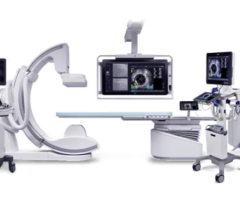
May 19, 2016 — A new imaging system known as intravascular photoacoustic (IVPA) imaging that produces three-dimensional images of the insides of arteries has the potential to help doctors diagnose plaques on the brink of rupturing. But scientists have struggled to develop imaging instruments that meet clinical requirements while illuminating arteries to a useful depth and at quick enough speeds.
Now, a team of researchers from Purdue University, Indiana University School of Medicine, Indiana, and the Shanghai Institute of Optics and Fine Mechanics, Shanghai, China, have improved upon previous instruments, developing a new IVPA catheter design with collinear overlap between optical and acoustic waves with a tiny probe. The design can greatly improve the sensitivity and imaging depth of IVPA imaging, revealing fatty arteries in all of their unctuous detail.
As plaque accumulates on the inside of arteries, it can cause the arteries to thicken and harden. When that plaque ruptures, it can ultimately block blood flow and lead to a heart attack, stroke or other problem throughout the body.
The condition, known as atherosclerosis, is a major form of cardiovascular disease, which over the past century has become the leading cause of death worldwide. Currently, no imaging tools are available to consistently and accurately diagnose plaque at risk of rupturing in living patients.
"The most exciting part of this work, which will be reported at the upcoming CLEO [Conference on Lasers and Electro-Optics] 2016 conference, is the collinear design of the catheter that enables the intravascular photoacoustic imaging system to see much deeper and much more lipid information in the arteries," said the first author Yingchun Cao, a postdoctoral fellow in Professor Ji-Xin Cheng’s group at Purdue University in West Lafayette, Ind. "That could provide valuable help for the doctor to better identify and diagnose the plaque vulnerability in patients."
IVPA imaging works by measuring ultrasound signals from molecules exposed to a light beam from a fast-pulsing laser. The new probe allows the optical beam and sound wave to share the same path all the way during imaging — that's the "collinear" overlap part — rather than cross overlap as in previous designs.
This increases the sensitivity and the imaging depth of the instrument, allowing for high-quality IVPA imaging of a human coronary artery over 6 mm in depth — from the lumen, the normally open channel within arteries, to perivascular fat, which surrounds the outside of most arteries and veins.
The Cheng laboratory had previously tried a design based on a ring-shaped transducer to accomplish the same collinear overlap idea. But the size of the transducer prevented its further application in clinic. The team came up with the current design by transmitting the optical wave while reflecting the sound wave on an angled surface. "It wasn't easy," said Cheng. "We tried different fibers, micro mirrors, and various assembly methods. Fortunately, we finally got this idea to work."
For more information: www.nature.com/srep


 December 20, 2023
December 20, 2023 








